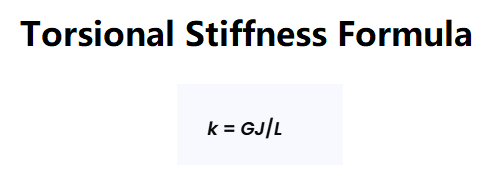1. What is Beam Torsional Stiffness Calculator?
Definition: This calculator computes the torsional stiffness (\( k \)) of a beam, which measures its resistance to twisting under a torsional load.
Purpose: It is used in structural engineering to evaluate how much a beam will twist under a given torque, aiding in the design of safe and efficient structures.
2. How Does the Calculator Work?
The calculator uses the following formula:
Formula:
Where:
- \( k \): Torsional stiffness (N m/rad)
- \( G \): Shear modulus (Pa)
- \( J \): Polar moment of inertia (m⁴)
- \( L \): Beam length (m)
Unit Conversions:
- Shear Modulus (\( G \)):
- 1 GPa = 10⁹ Pa
- 1 MPa = 10⁶ Pa
- 1 Pa = 1 Pa
- Polar Moment of Inertia (\( J \)):
- 1 m⁴ = 1 m⁴
- 1 cm⁴ = 10⁻⁸ m⁴
- 1 mm⁴ = 10⁻¹² m⁴
- 1 in⁴ = (0.0254)⁴ m⁴
- Beam Length (\( L \)):
- 1 m = 1 m
- 1 cm = 0.01 m
- 1 mm = 0.001 m
- 1 in = 0.0254 m
- 1 ft = 0.3048 m
- Torsional Stiffness (\( k \)):
- 1 N m/rad = 1 N m/rad
- 1 kN m/rad = 10³ N m/rad
- 1 MN m/rad = 10⁶ N m/rad
Steps:
- Select a material or choose "Custom" to input a shear modulus (\( G \)).
- Enter the polar moment of inertia (\( J \)) and beam length (\( L \)) with their respective units.
- Convert all inputs to base units (Pa, m⁴, m) for calculation.
- Calculate the torsional stiffness (\( k \)) using the formula \( k = \frac{GJ}{L} \).
- Convert the result to the selected unit for display.
- Display the result with 4 decimal places.
3. Importance of Torsional Stiffness Calculation
Calculating the torsional stiffness is crucial for:
- Structural Design: Ensuring beams can resist twisting under torsional loads without excessive deformation.
- Material Selection: Choosing materials with appropriate shear modulus for specific applications.
- Safety Analysis: Verifying that structural components meet safety standards by evaluating their torsional resistance.
4. Using the Calculator
Example:
Calculate the torsional stiffness for a steel beam with \( G = 75 \, \text{GPa} \), \( J = 1 \times 10^6 \, \text{mm}^4 \), and \( L = 2 \, \text{m} \).
- Select the material as "Steel alloys (A-36, A992, 304)".
- Enter \( J = 1 \times 10^6 \, \text{mm}^4 \) and \( L = 2 \, \text{m} \).
- The calculator computes:
- Convert to base units: \( G = 75 \times 10^9 \, \text{Pa} \), \( J = 1 \times 10^6 \times 10^{-12} = 1 \times 10^{-6} \, \text{m}^4 \), \( L = 2 \, \text{m} \).
- \( k = \frac{GJ}{L} = \frac{(75 \times 10^9) \times (1 \times 10^{-6})}{2} = 37,500,000 \, \text{N m/rad} \).
- In selected unit (N m/rad): \( k = 37,500,000 \, \text{N m/rad} \).
5. Frequently Asked Questions (FAQ)
Q: What is torsional stiffness?
A: Torsional stiffness (\( k \)) is a measure of a beam's resistance to twisting under a torsional load, defined as the torque required to produce a unit angle of twist.
Q: Why is torsional stiffness important in structural engineering?
A: It helps engineers design beams that can withstand torsional loads without excessive twisting, ensuring structural stability and safety.
Q: How does the calculator handle different units?
A: The calculator allows users to input values in various units and converts them to base units (Pa, m⁴, m) for calculation. The result can be displayed in user-selected units (N m/rad, kN m/rad, MN m/rad).
Beam Torsional Stiffness Calculator© - All Rights Reserved 2025
 Home
Home
 Back
Back
